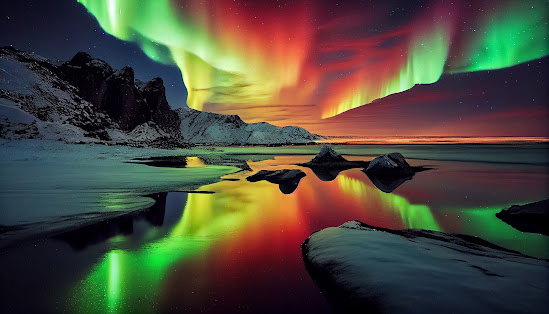 |
| Image credit: QuantumCurator |
In the past few days, the night skies have been adorned with a breathtaking view in many parts of the world that took the attention of people across the globe—the Aurora Borealis, also known as the Northern Lights. This natural phenomenon, typically confined to the polar regions, has graced the heavens over diverse landscapes, from the vast expanses of Europe to the remote corners of Ladakh, India.
But what exactly is this mesmerizing display, and why has it ventured so far from its usual domain?
A Dance of Light and Magnetism
 |
| Image Credits: Alphacoders |
The Aurora Borealis is a celestial ballet of shimmering lights, an ethereal display that has fascinated humanity for centuries. But its beauty is not merely superficial; it's a manifestation of intricate interactions between charged particles from the Sun and the Earth's magnetic field.
At the heart of this phenomenon lies the Sun, our radiant star, which continuously releases a stream of charged particles and magnetic fields into space, known as the solar wind. When these particles collide with the Earth's magnetic field, they're channeled towards the polar regions, where they interact with gases in the upper atmosphere, primarily oxygen and nitrogen.
The Mechanism Behind the Magic
 |
| Illustration by Shutterstock |
As the charged particles collide with oxygen and nitrogen molecules in the Earth's atmosphere, they energize these gases, causing them to emit light of various colors. Oxygen atoms, when excited, produce the iconic green hue of the Northern Lights, while nitrogen contributes to the vibrant shades of blue, purple, and pink.
But what triggers this celestial light show to extend beyond its usual confines? The recent sightings of the Aurora Borealis in unexpected locales can be attributed to a surge in solar activity, marked by a series of solar storms and coronal mass ejections (CMEs) from the Sun's surface. These intense bursts of energy propel charged particles towards Earth, creating optimal conditions for the Northern Lights to grace skies far from the polar regions.
Solar Storms
The recent surge in solar activity, culminating in a significant solar storm, has sparked both wonder and curiosity among sky watchers worldwide. But what are these solar storms, and should we be concerned about their impact on our planet?
Solar storms, characterized by the eruption of charged particles from the Sun, are a natural consequence of the Sun's dynamic behavior. Coronal mass ejections (CMEs), in particular, unleash torrents of charged gas into space, occasionally directed towards Earth. While these storms pose no direct threat to human health, they can disrupt electronic devices and satellite communications, underscoring the importance of understanding space weather phenomena.
As we marvel at the celestial spectacle unfolding above, it's essential to appreciate the delicate balance between solar activity and Earth's magnetic field that gives rise to the Aurora Borealis. This captivating display serves as a reminder of the interconnectedness of our planet with the vast reaches of space, inviting us to ponder the mysteries of the cosmos.
So, the next time you find yourself gazing up at the night sky, remember that beyond the twinkling stars lies a world of wonder waiting to be explored—a world illuminated by the timeless beauty of the Aurora Borealis


Comments
Post a Comment